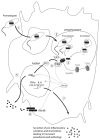Muco-cutaneous leishmaniasis in the New World: the ultimate subversion
- PMID: 21971185
- PMCID: PMC3260548
- DOI: 10.4161/viru.2.6.17839
Muco-cutaneous leishmaniasis in the New World: the ultimate subversion
Abstract
Infection by the human protozoan parasite Leishmania can lead, depending primarily on the parasite species, to either cutaneous or mucocutaneous lesions, or fatal generalized visceral infection. In the New World, Leishmania (Viannia) species can cause mucocutaneous leishmaniasis (MCL). Clinical MCL involves a strong hyper-inflammatory response and parasitic dissemination (metastasis) from a primary lesion to distant sites, leading to destructive metastatic secondary lesions especially in the nasopharyngal areas. Recently, we reported that metastasizing, but not non-metastatic strains of Leishmania (Viannia) guyanensis, have high burden of a non-segmented dsRNA virus, Leishmania RNA Virus (LRV). Viral dsRNA is sensed by the host Toll-like Receptor 3 (TLR3) thereby inducing a pro-inflammatory response and exacerbating the disease. The presence of LRV in Leishmania opens new perspectives not only in basic understanding of the intimate relation between the parasite and LRV, but also in understanding the importance of the inflammatory response in MCL patients.
Figures

Comment on
-
Leishmania RNA virus controls the severity of mucocutaneous leishmaniasis.Science. 2011 Feb 11;331(6018):775-8. doi: 10.1126/science.1199326. Science. 2011. PMID: 21311023 Free PMC article.
References
-
- Ronet C, Ives A, Bourreau E, Fasel N, Launois P, Masina S. Immune responses to Leishmania guyanensis infection in humans and animal models. In: Jirillo E, Brandonisio O, editors. Immune Response to Parasitic Infections: Protozoa. Bussum: Bentham eBooks; 2010. pp. 165–177.
Publication types
MeSH terms
Substances
Grants and funding
LinkOut - more resources
Full Text Sources
